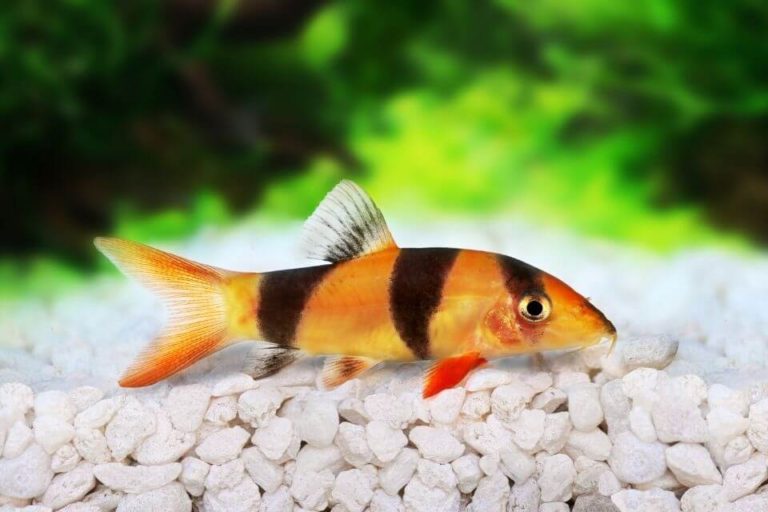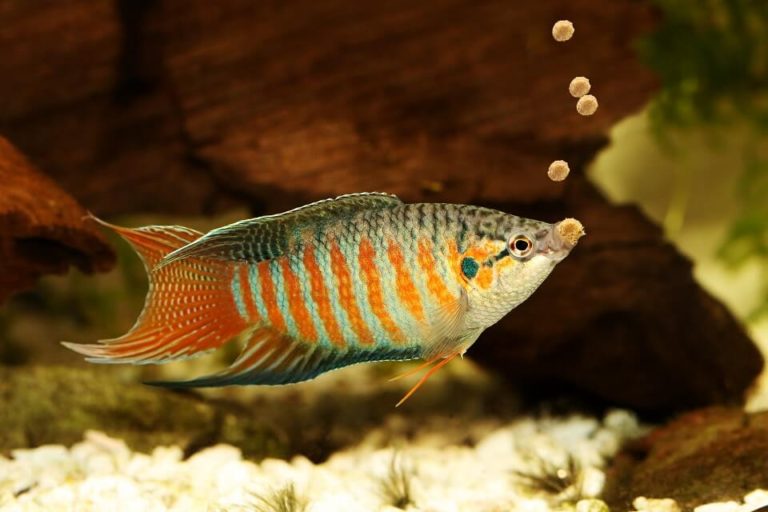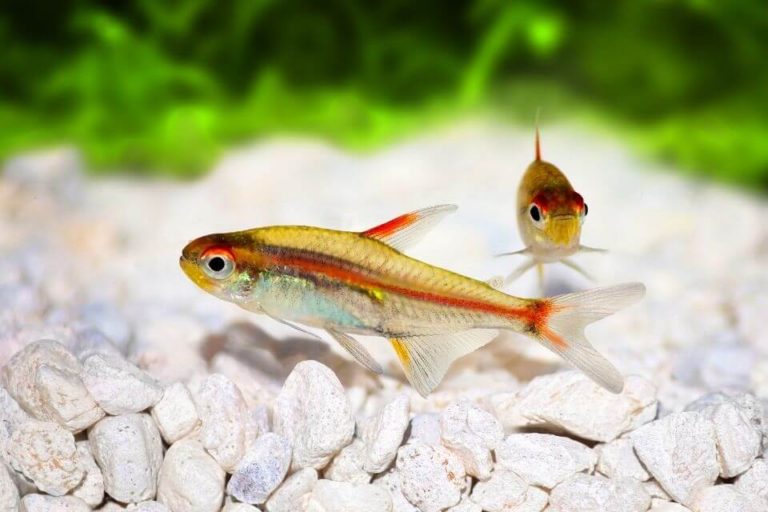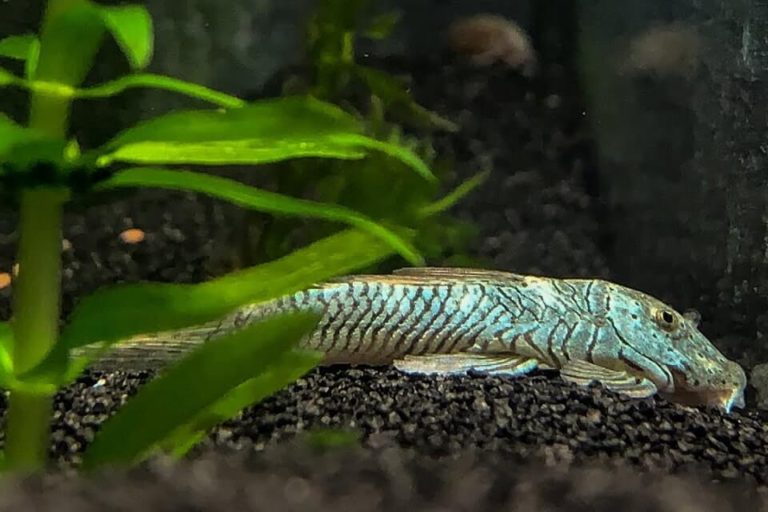Zebra Loach Care Guide and Species Profile – Tank Setup and Feeding
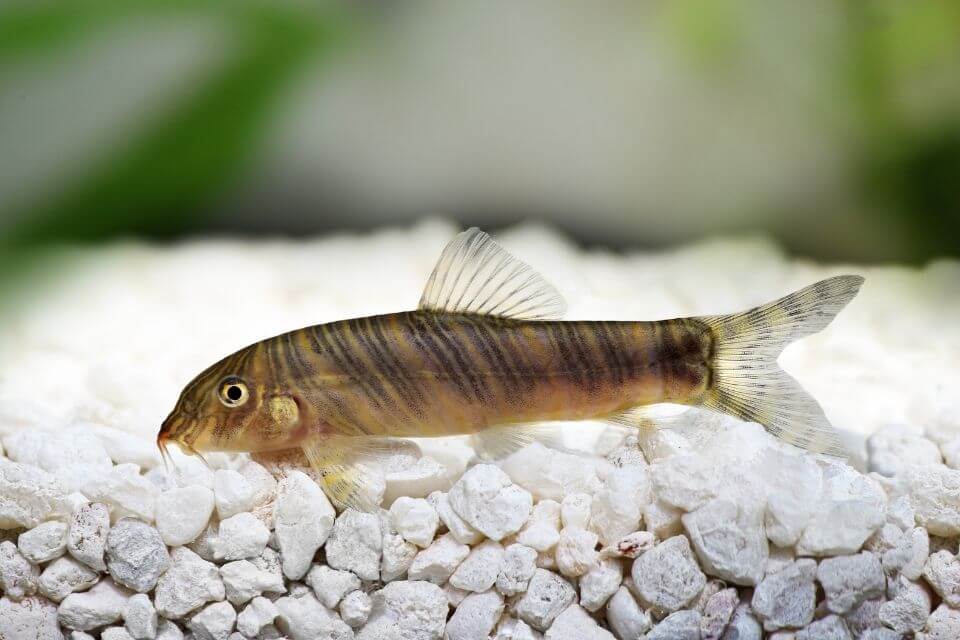
If you are a beginner aquarist looking for a beautiful fish to decorate your tank with, the Zebra Loach is a good choice. This bottom-dwelling freshwater fish is peaceful and relaxed, helping you learn the best ways to take care of your fish at home.
If you want to start your fish-keeping hobby with success, take a look at this complete Zebra Loach care guide. In it, you’ll learn more about the characteristics and behaviors of the species.
Furthermore, you will know about habitat requirements and conditions for the comfort and care of these unique and mesmerizing fish species.
| Quick Facts: | |
|---|---|
| Common Names : | Zebra Loach |
| Origin : | Rivers and streams in the Western Ghats, India |
| Family : | Botiidae |
| Scientific Name : | Botia striata |
| Care Level : | Easy |
| Temperament : | Peaceful |
| Social : | Communiti fish |
| Diet : | Omnivores |
| Size (average) : | 3 to 4 inches |
| Lifespan : | Up to 15 years |
| Breeding : | Egg layer |
| Minimum Tank Size: | 30 gallons |
| Tank Environment : | Freshwater , Sandy substrate, Floating Plants, Lot of hiding places, Rocks and Driftwood |
| Temperature : | 73 – 79 °F (21 – 26 °C) |
| Water Hardness : | 2 - 10 dKH |
| Water pH Level : | 6.0 - 7.5 |
Species Overview
The Zebra Loach is an interesting fish species that has many origins around the world, and many possible freshwater sources it is indigenous to. They sport beautifully unique stripes that are surreal to watch when they swim calmly through the water.
You’ll usually spot the Zebra Loach at the bottom of the tank, as they love to search the substrate for food. They are typical bottom feeders, making them very easy to care for.
You can find a lot of viable tank setup options, decorations, and tank mates that will all work well with a Zebra Loach.
Appearance, Colors, and Special Markings
The Zebra Loach has a very unique appearance that makes it a popular choice among beginner and experienced aquarists with tanks of all sizes.

The stripes on the Zebra Loach are very recognizable and give the fish its name. The unique pattern of thick and thin white and yellow stripes stretch vertically across the body from head to tail.
In between the white stripes are shades of brown that serve as the base color of the fish. The casual and dorsal fins are covered in dark grey and black stripes, completing the zebra-like look.
The shape and size of the Zebra Loach are very similar to that of other Loaches. If you are familiar with other Loach species, you can find a lot of familiarity with this dazzling fish.
Gold Zebra Loach (Botia histrionica)
There is another species of fish known as the Gold Zebra Loach or Golden Zebra Loach, which is a smaller yet similarly peaceful fish. This species is scientifically known as Botia histrionica.
This bottom feeder has thicker black stripes in-between shades of gold that glimmer when the fish swims around.
Zebra Loach Size
One of the most important factors to consider when choosing the right tank size for a Zebra Loach is how big it can get as an adult, as well as how rapidly it grows as an adolescent.
Average Zebra Loach size can reach 3 to 4 inches in length when fully grown. They can grow quickly when they are small, so you can prepare your fish tank to accommodate that.
Zebra Loach Lifespan
The Zebra Loach may not be the biggest Loach species in the market, but it is certainly one of the hardiest. With good care and proper tank conditions, the Zebra Loach can live up to 15 years, or at least over a decade, in the comfort of your home aquarium.
You can raise the same Zebra Loach fish for a long time, allowing them to be great family companions in your home.
Behavior & Temperament
When it comes to temperament and behavior, the Zebra Loach is not too complicated. This is why it can be such an easy freshwater fish to care for. The most noticeable behavior is that this fish will spend most of its time hanging out around the bottom of the tank.
They love to search for snacks and algae at the bottom of the aquarium and like to explore, and you might enjoy how curious these fish can be.
They tend to hide from time to time, but then they will dart back out into the open and become playful. These Loach species are fun to watch, making them a popular choice for living room fish tanks.
When it comes to interactions with other fish, the Zebra Loach is quite peaceful. There are many fish species that can be acceptable as Zebra Loach tank mates, especially if both species are equally friendly.
There are some times where this fish can become a little aggressive, but that usually only happens when the fish is alone or feels threatened. For this reason, it is recommended to keep a few Zebra Loaches together in a tank with proper conditions.
Zebra Loach Care and Habitat
There are several reasons why the Zebra Loach is highly recommended to beginning aquarists or those who are looking for an easygoing fish. They are easy to feed and get along with.
Perhaps the most difficult and time-consuming part of their care is making sure to set up their tank correctly.
Tank conditions can make or break your Zebra Loach’s life in your tank. Take note of the following specifications very closely so you know you can best care for your new fish.
Overall, the Zebra Loach is very low-maintenance. Beginners should have an easy time taking care of themselves. They are good-natured and feed passively on things that grow in the tank, so you should be able to achieve care success without much work.
Follow the below recommendations to correctly set up their tanks to ensure a lifetime of easy care and enjoyment of your fish.
Zebra Loach Tank Size
No matter what kind of fish you have, the bigger the tank is always better for their health. That being said, with a Zebra Loach you should have a tank that is at least 30 gallons in size.
You might not think that a fish that small needs so much space, but they are active swimmers. It is also a good idea to keep at least 5 Zebra Loaches together, which is another reason why a larger tank would be best for these fish.
If you are considering adding more tank mates for your fish, you will want to invest in a tank of an even larger size. You can’t go wrong with a large tank!
Tank Setup
The best way to give your Zebra Loaches a happy habitat is to imitate their natural surroundings. Here are some of the most important tips.
In the wild, they often scan the sand or the soft rocky bottom of the water for food. You can add similar substrates to keep them always on the search. Make sure you go with something soft, as rougher substrate can cause cuts and scrapes.
These fish species also love plants. Make sure to add a decent amount of living plants around the tank, while still giving them enough room to swim around in. Vegetation and algae are what they love to snack on, and this can be the easiest way to feed them as well.
The most important thing you can give Zebra Loaches in your tank is room to swim. They will always be moving around and searching the bottom of the tank, so be sure not to make it too crowded.
Some decorations and rocks are fine, as the fish will sometimes want to hide. But for the most part, they shouldn’t be given anything that could block their path.
Zebra Loaches are used to dimly lit waters in the wild. Make sure to keep your lights on low so your fish can enjoy murky waters. Make sure the plants you use for the tank can thrive in low-light situations as well.
Water Conditions and Parameters
Water conditions are of utmost importance when it comes to maintaining the health and comfort of your fish. Zebra Loaches are used to different types of environments in the wild, but you should know what they need to thrive.
Make sure to follow these parameters when setting up water conditions for the Zebra Loach.
Water Temperature: Zebra Loaches are from certain parts of the world with very warm waters. It is important to maintain their tropical and humid conditions as much as possible.
The ideal water temperature for their tank should measure between 73°F and 79°F at all times.
Water Acidity: The pH levels of the water help to keep the tank fresh and free of harmful bacteria. But waters that are too acidic may make it difficult for your fish to breathe. Try to keep your water hardness levels between 6 and 7.5 pH.
Water Hardness: Zebra Loaches are very adaptable when it comes to water hardness levels. It’s easier to maintain their water levels because these fish can get used to a little bit of change. Try to maintain water hardness levels between 2 and 10 dKH.
Consistency is key when it comes to keeping your fish healthy. Zebra Loaches can thrive within a range of temperatures, but constant fluctuations can make them very ill. It is best for the whole ecosystem of your aquarium to keep things at a consistent temperature, hardness, and acidity level.
Water temperature: 73 – 79 °F (21 – 26 °C) Acidity: 6.0 – 7.5 pH Water hardness: 2 – 10 dKH
Suitable Plants
You should encourage a few algae to grow in your aquarium. This is one of Zebra Loach’s favorite things to eat! Not only can you let them feed freely, but you can automatically manage the levels of algae in your tank without ever worrying about it getting overgrown.
You can add some lush live plants into your tank. Your Loaches may nibble on them, but for the most part, they will enjoy using them for places to hide.
Try to avoid carpet plant species, because they can grow from the substrate and create too many obstacles for your free-swimming fish.
Possible Diseases and Prevention
Yet another reason why Zebra Loaches are recommended for beginners is that they are durable. They can stay very healthy as long as they receive good care and proper feeding.
But that does not mean that they are invincible. Zebra Loaches are still susceptible to some of the common illnesses that most freshwater species can get.
Ich:
As the most common freshwater fish illness, Ich causes a skin condition in which fish will scratch themselves against rocks to relieve pain.
White blotches will appear on their scales and they will start to act erratically. There is some medicine that you can add to your tank to treat the condition.
Infection:
Rather than trying to be on the lookout for specific diseases, it is important to look for the signs of infection in your fish.
Zebra Loaches spend so much time at the bottom of the tank that they risk cutting themselves on rocks or decorations. Cuts can lead to infection if not properly treated. Make sure your water conditions are always pristine.
Origin, Distribution, and Availability
The Zebra Loach primarily hails from the western region of India. They like to inhabit small rivers and streams with slow-moving waters, as they like to stay still for some time.
Unfortunately, the region of their natural habitat has been dramatically changed due to industrialization and deforestation, forcing them into other regions.
While the Zebra Loach is currently considered an endangered species in the wild. But there are still plenty of places where you can easily find them for sale.
Just be sure to use caution when learning about the seller’s practices when it comes to acquiring a species such as the Zebra Loach.

Where Can We Find Zebra Loach for Sale?
There are many ways to get your hands on a group of beautiful Zebra Loaches for your home aquarium. You can find Zebra Loach for sale through local breeders, freshwater fish distributors, and reputable online sources, you can get some Zebra Loaches in a short amount of time.
They may be rare in the wild, but there are safe breeding practices in captivity that have allowed them to be sold around the world as an easy choice for aquarium-owning beginners.
Average Zebra Loach Price
Depending on availability and stock, the Zebra Loach can be quite an affordable choice for your tank. In the USA, they can be found starting at prices of $6.99 and up.
Again, it depends on who you purchase the fish from and where you are located. A group of 5 Zebra Loaches – the recommended number for your tank – would cost around $35 to get started.
Zebra Loach Diet and Feeding
As omnivores, Zebra Loaches can eat a wide variety of things. This will make it easy for you to feed them, as there are several ways to accomplish this.
Just make sure that you are giving them plenty of healthy and well-rounded options while also supplementing their diet with the occasional treat.
Some of the base foods you should be including for them on a daily basis include:
- Catfish pellets
- Algae
- Fish flakes
- Vegetables (zucchini, cucumbers, spinach, and lettuce)
In addition to these essentials, make sure to drop them plenty of protein-filled snacks such as:
- Brine shrimp
- Bloodworms
- Daphnia
- Mosquito larvae
They will naturally feed on the algae and plant matter that build up around the sides of the tank. It is important not to overfeed them as they are natural grazers, and you will see them eating at various times throughout the day.
Zebra Loach Tank Mates
First and foremost, it is essential that you pair your Zebra Loach with other Zebra Loaches. You should have at least 5 in your group, but more is also encouraged. They tend to get aggressive with each other if there aren’t enough of them.
As long as they are in a group with each other, they will remain peaceful and fun. As long as you have the room for it in your tank, you can add other peaceful and similarly-sized fish such as:
Speak with your local fish providers about other options that may be well-suited with the Zebra Loaches in your tank.
Zebra Loach Breeding
It is not possible to breed Zebra Loach fish in your home aquarium. Many people have tried, but there has not yet been a success story of a breeding attempt at home.
It is not recommended to breed them at home and it could be wasting your time. But, it will not be encouraged to breed if you do not go out of your way to set up breeding conditions for them.
It is important to continue focusing on the health and comfort of your Zebra Loach school. They may not breed, but they will live long and happy lives in your tank.

Gender Differences
There aren’t too many signifiers between male and female Zebra Loach fish, but there are some subtle characteristics you may notice.
For example, females are more full in the abdomen than males. Males also tend to get slightly larger and may have leaner or more elongated bodies.
Otherwise, there are no essential qualities to sex this fish. Since it is not easy to breed them in your tank, you do not have to be concerned with any differences in care needs between male and female Zebra Loaches.
How Many Zebra Loaches Should Be Kept Together?
The Zebra Loach thrives in groups and we do not recommend keeping them alone. It is a good idea to keep at least 5 of them together in your tank and even more if you are able to.
When they can be together in their own school, they feel much safer and more secure. This leads to them feeling peaceful and friendly, making them much more fun to look at!
If you just have one or two of them in your tank, there is a small possibility that they will get aggressive. But, it is not difficult to acquire several of them for your aquarium.
Are Zebra Loaches Aggressive?
Zebra Loaches are not aggressive unless they feel isolated. And even then, they are not aggressive as much as they are a little agitated and feisty.
They do not tend to attack other fish species and will remain peaceful even when interacting with aggressive fish. They take comfort in their groups and will swim around peacefully at the bottom of your tank.
The Zebra Loach gets along with many different freshwater species, making it easy to adapt into your tank. Friendly tank mates can help you complete the ecosystem in your very own home aquarium.
Do Zebra Loaches Eat Snails?
The Zebra Loach can eat snails if they are available. Most specifically, the Golden Zebra Loach likes to eat small snails and shrimp.
They have been used around the world to get rid of snails that have been considered pests in some underwater habitats. It’s important to be careful with your pet snails, however.
If your aquarium houses larger ornamental snails that you would like to keep alive, you might not want to put a Zebra Loach in the same environment.
Depending on the size of the snail, the Loach may try to eat it. Very large snails should not have this problem, as they are too large to be eaten by Zebra Loaches.
Can Bettas Live with Zebra Loaches?
Most breeds of Bettas are very good tank mates for Zebra Loaches. You can pair them together as they are similar in size and in temperament.
Both of these fish also have nocturnal habits, so you may see them interact more during the night. Keep in mind that Bettas like to live solitary lives, so make sure there is still enough room for your Betta to be on its own.
Not to mention, Bettas usually swim around all parts of the tank. Your Loaches will remain at the bottom. It is not likely that they will come across each other or get into a fight.
Final Thoughts
Because they are easy to take care of, easy to feed, and easy to acquire, the Zebra Loach is a great choice for beginner aquarists.
Whether you are setting up your very first aquarium or adding to an already existing tank, you will find a lot of enjoyment in a group of Zebra Loaches.
The most important aspect of their care is maintaining their tank and water conditions so that they remain healthy and stable. Encourage a bit of algae production so they can naturally graze as they get hungry.
These long-lasting fish species can be beautiful additions to your home that will entertain you and your guests for over a decade.




